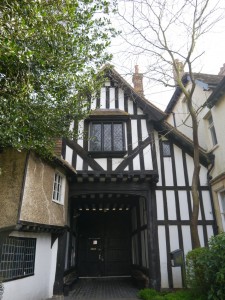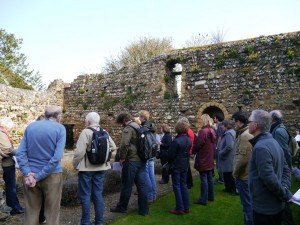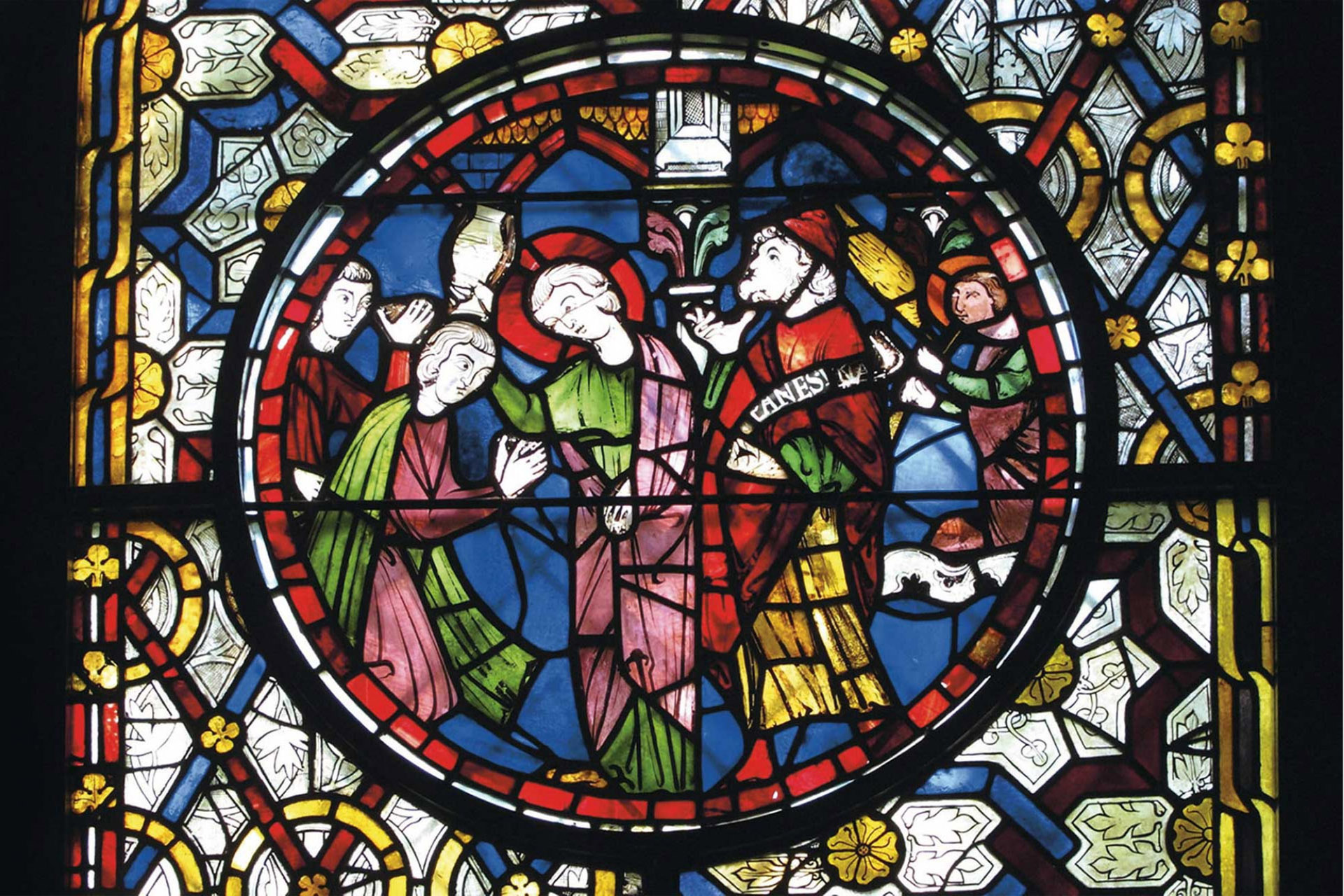On a dry but blustery March day a group of almost thirty MEMS friends and postgraduates joined Centre staff members Helen Gittos and Jacqueline Basquil on a guided tour of this  fantastic medieval institution led by Douglas, one of the brothers at the hospital, and Sheila Sweetinburgh. Situated on what had been archiepiscopal land in the Northgate suburb of Canterbury, St John’s was founded almost a thousand years ago in c.1084 by Archbishop Lanfranc. Together with its sister house at Harbledown, these hospitals may be the first specifically designed buildings to provide charitable care for the poor, infirm, and, at St Nicholas’ in Harbledown, the leprous. Both houses were sited abutting main highways into Canterbury, good places for the collection of alms from passing travellers and pilgrims, and even though the Tudor gatehouse at St John’s is a later replacement, the group was able to see medieval collecting boxes that may have been used by the hospital’s gatekeeper as he kept watch from the little first-floor window that gives on to Northgate.
fantastic medieval institution led by Douglas, one of the brothers at the hospital, and Sheila Sweetinburgh. Situated on what had been archiepiscopal land in the Northgate suburb of Canterbury, St John’s was founded almost a thousand years ago in c.1084 by Archbishop Lanfranc. Together with its sister house at Harbledown, these hospitals may be the first specifically designed buildings to provide charitable care for the poor, infirm, and, at St Nicholas’ in Harbledown, the leprous. Both houses were sited abutting main highways into Canterbury, good places for the collection of alms from passing travellers and pilgrims, and even though the Tudor gatehouse at St John’s is a later replacement, the group was able to see medieval collecting boxes that may have been used by the hospital’s gatekeeper as he kept watch from the little first-floor window that gives on to Northgate.
Initially there were sixty brothers and sisters, cared for spiritually by a community of regular priests who lived across the road in Northgate [from the mid 12th century it became St Gregory’s Priory, a house of Augustinian canons, who continued this charitable work]. The brothers and sisters at St John’s lived communally in two separate splendid, stone-constructed dormitory halls, and were similarly kept apart in the adjoining chapel. Now open to the sky, the group  examined part of probably the female northern dormitory hall, which includes early features such as a corner spiral stair-turret, a complete first floor window and an original doorway, with timber lintels and a ‘tympanum’ area. The group also noted the pinkish colour of the Caen stonework, the result of the mid 14th century fire when much of the building was presumably badly damaged, although whether there were still a hundred brothers and sisters [the hospital’s peak] at the time is unknown.
examined part of probably the female northern dormitory hall, which includes early features such as a corner spiral stair-turret, a complete first floor window and an original doorway, with timber lintels and a ‘tympanum’ area. The group also noted the pinkish colour of the Caen stonework, the result of the mid 14th century fire when much of the building was presumably badly damaged, although whether there were still a hundred brothers and sisters [the hospital’s peak] at the time is unknown.
The surviving necessaria [multi-seat privies] caused considerable comment, not least because the ‘women’s’ late 11th century privy block continued as originally intended until the 1940s. However there had been some modifications over the centuries as can be seen – somewhat more comfortable, perhaps, but still drafty! Nevertheless much of building was as Lanfranc had dictated, and again the group saw several early features like windows and arches, for water channels to take away the effluent – the forerunner of modern plumbing.
Much less survives from the original double chapel, but the group was able to admire the 13th century font and the early south door that had been relocated to the west end. Sadly the medieval glass has gone but it is known that the great east window had had the Twelve Apostles, and similarly the Lady Chapel had contained high-quality stained glass. The latter had been provided by John Roper [of the wealthy St Dunstan’s Roper family – visit the fine Roper gateway and the reputed head of Sir Thomas More in the church there] in 1526 when he founded a post-mortem chantry of two priests, an expensive undertaking which makes his presence at the hospital especially interesting.
 Finally the group trooped up the Tudor spiral stair turret to the refectory [the building constructed using the rear wall of the ‘men’s’ dormitory and the front wall of the corresponding necessaria], to view the three medieval chests, the great table, a number of pewter dishes and the almsboxes. By the 16th century much of the earlier communal living had ceased, but the brothers and sisters still held feasts together: Lanfranc’s obit day, the Nativity of St John the Baptist and to commemorate their deceased brothers and sisters, the latter involving dining on bread, ale and cheese. Some feasts were more extensive, roasts prepared on the spits in the kitchen below the refectory, parts of this apparatus still visible in the great fireplace, but, as Douglas observed, although the community continues certain of these traditions the brothers and sisters celebrate in the comfortable, modern refurbished ‘kitchen’ not the refectory above.
Finally the group trooped up the Tudor spiral stair turret to the refectory [the building constructed using the rear wall of the ‘men’s’ dormitory and the front wall of the corresponding necessaria], to view the three medieval chests, the great table, a number of pewter dishes and the almsboxes. By the 16th century much of the earlier communal living had ceased, but the brothers and sisters still held feasts together: Lanfranc’s obit day, the Nativity of St John the Baptist and to commemorate their deceased brothers and sisters, the latter involving dining on bread, ale and cheese. Some feasts were more extensive, roasts prepared on the spits in the kitchen below the refectory, parts of this apparatus still visible in the great fireplace, but, as Douglas observed, although the community continues certain of these traditions the brothers and sisters celebrate in the comfortable, modern refurbished ‘kitchen’ not the refectory above.
So as the group  gathered on the Green to thank Douglas for showing them this hidden gem, there may have been some within the group who had noted the attractions of the place for future reference.
gathered on the Green to thank Douglas for showing them this hidden gem, there may have been some within the group who had noted the attractions of the place for future reference.
Sheila Sweetinburgh 25.03.14.
